Research on the Influence of Abrupt Climate Changes on the Analysis of Typical Meteorological Year in China
Abstract
1. Introduction
2. The Methods to Identify Abrupt Climate Changes
3. Timescales of Meteorological Records Adopted in a TMY Analysis with the Consideration of ACC
3.1. Timescale Selection Principles
3.2. The Impact of the Quality of Original Meteorological Records on the Tested Results of MTT
3.3. Timescales Selection for the Sample Cities in China
3.3.1. Using the Annual Average Data
3.3.2. Using the Monthly Average Data
4. The Impact of ACC on a TMY Development
4.1. The TMY Development Method in China
4.2. The Improved TMY Development for Six Selected Cities
5. The Influence on Building Energy Consumption Simulations and Adaptive Thermal Comfort Temperatures
5.1. Impact on Building Energy Consumption Simulations
5.2. Impact on Adaptive Thermal Comfort Temperatures
6. The Influence of ACC on Outdoor Design Parameters
- outdoor design temperature during heating periods, which is the fifth coldest daily temperature of each year over a TMY timescale.
- outdoor design temperature for winter ventilation, which is the average outdoor temperature of the coldest month of each year over a TMY timescale.
- outdoor calculated dry-bulb temperature during summer cooling period, which is the 50th hottest hourly average dry-bulb temperature of each year over a TMY timescale.
- outdoor design temperature for summer ventilation, which is the monthly average mean temperature at 14 o’clock in the hottest month of each year over a TMY timescale.
7. Conclusions
Author Contributions
Funding
Acknowledgments
Conflicts of Interest
Nomenclature
| TMY | Typical meteorological year |
| TMMs | Typical meteorological months |
| CSWD | Chinese standard weather database method |
| TPCY | Typical principal component years method |
| CTYW | Chinese typical year weather method |
| DFMs | Diffuse fraction models for the hourly solar radiation |
| MTT | Moving t-test method |
| ACC | Abrupt climate changes |
| BESTEST | Building energy simulation test |
| i | Meteorological parameters |
| m | Month |
| Y | Year |
| Ki | Weighting factors |
| Ρ | Air density, kg/m3 |
| Qnew | Energy consumption based on new timescales of raw data; kWh/m2 |
| Qold | Energy consumption based on 1989-2019, kWh/m2 |
| Te | Outdoor design temperature for heating, °C |
| Tn | Operative temperature, °C |
| Tout | Running mean of outdoor temperature, °C |
| Tn | Indoor design temperature, °C |
| To | Outdoor design temperature for winter ventilation, °C |
| A | Area, m2 |
| Qwinter-heating | Winter heating load, W |
| V | Ventilation volume, m3 |
| U-value | Heat transfer coefficient, W/(m2·K) |
| Qwinter-ventilation | Winter ventilation load, W |
| Cp | Specific heat capacity, J/(kg·K) |
Appendix A
References
- Givoni, B. Climate Considerations in Building and Urban Design, 1st ed.; John Wiley & Sons: New York, NY, USA, 1998; pp. 12–30. [Google Scholar]
- Herrera, M.; Natarajan, S.; Coley, D.A.; Kershaw, T.; Ramallo-González, A.P.; Eames, M.; Fosas, D.; Wood, M. A review of current and future weather data for building simulation. Build. Serv. Eng. Res. Technol. 2017, 38, 602–627. [Google Scholar] [CrossRef]
- Chan, A.L.S. Generation of typical meteorological years using genetic algorithm for different energy systems. Renew. Energy 2016, 90, 1–13. [Google Scholar] [CrossRef]
- David, M.; Adelard, L.; Lauret, P.; Garde, F. A method to generate Typical Meteorological Years from raw hourly climatic databases. Build. Environ. 2010, 45, 1722–1732. [Google Scholar] [CrossRef]
- Janjai, S.; Deeyai, P. Comparison of methods for generating typical meteorological year using meteorological data from a tropical environment. Appl. Energy 2009, 86, 528–537. [Google Scholar] [CrossRef]
- Zang, H.; Xu, Q.; Wang, W.; Chen, K. A step-by-step application of Danish method for generation of typical meteorological years of China. J. Renew. Sustain. Energy 2013, 5, 053145. [Google Scholar] [CrossRef]
- Festa, R.; Ratto, C.F. Proposal of a numerical procedure to select Reference Years. Sol. Energy 1993, 50, 9–17. [Google Scholar] [CrossRef]
- Zang, H.; Xu, Q.; Bian, H. Generation of typical solar radiation data for different climates of China. Energy 2012, 38, 236–248. [Google Scholar] [CrossRef]
- Hall, I.J.; Prairie, R.R.; Anderson, H.E.; Boes, E.C. Generation of a typical meteorological year. In Proceedings of the 1978 Annual Meeting of the American Section of the International Solar Energy Society. Conference: Analysis for Solar Heating and Cooling, Sandia Labs., Albuquerque, NM, USA, 27 June 1978; pp. 669–671, report number: SAND-78-1096C.; CONF-780639-1. [Google Scholar]
- Lu, S.; Emura, K.; Igawa, N. Statistical characteristics of five sets of Standard Year Weather Data in China. Archit. Sci. Rev. 2010, 53, 415–428. [Google Scholar] [CrossRef]
- Center, N.M.I. Building Thermal Environment Analysis Dedicated Meteorological Data Sets of China; China Architecture & Building Press: Beijing, China, 2005; pp. 1–165. [Google Scholar]
- Sun, J.; Li, Z.; Xiao, F. Analysis of Typical Meteorological Year selection for energy simulation of building with daylight utilization. Procedia Eng. 2017, 205, 3080–3087. [Google Scholar] [CrossRef]
- Zhang, Q. Development of the typical meteorological database for Chinese locations. Energy Build. 2006, 38, 1320–1326. [Google Scholar] [CrossRef]
- Zhang, Q.; Huang, J.; Yang, H. Development of the typical and design weather data for Asian locations. J. Asian Archit. Build. Eng. 2002, 1, 2_49–2_55. [Google Scholar] [CrossRef][Green Version]
- Zang, H.; Wang, M.; Huang, J.; Wei, Z.; Sun, G. A Hybrid Method for Generation of Typical Meteorological Years for Different Climates of China. Energies 2016, 9, 1094. [Google Scholar] [CrossRef]
- Kalogirou, S.A. Generation of typical meteorological year (TMY-2) for Nicosia, Cyprus. Renew. Energy 2003, 28, 2317–2334. [Google Scholar] [CrossRef]
- Chan, A.L.S.; Chow, T.T.; Fong, S.K.F.; Lin, J.Z. Generation of a typical meteorological year for Hong Kong. Energy Convers. Manag. 2006, 47, 87–96. [Google Scholar] [CrossRef]
- Pissimanis, D.; Karras, G.; Notaridou, V.; Gavra, K. The generation of a “typical meteorological year” for the city of Athens. Sol. Energy 1988, 40, 405–411. [Google Scholar] [CrossRef]
- Huang, K.-T. Identifying a suitable hourly solar diffuse fraction model to generate the typical meteorological year for building energy simulation application. Renew. Energy 2020, 157, 1102–1115. [Google Scholar] [CrossRef]
- Gazela, M.; Mathioulakis, E. A new method for typical weather data selection to evaluate long-term performance of solar energy systems. Sol. Energy 2001, 70, 339–348. [Google Scholar] [CrossRef]
- de Miguel, A.; Bilbao, J. Test reference year generation from meteorological and simulated solar radiation data. Sol. Energy 2005, 78, 695–703. [Google Scholar] [CrossRef]
- Liu, Y.; Wan, K.K.W.; Li, D.H.W.; Lam, J.C. A new method to develop typical weather years in different climates for building energy use studies. Energy 2011, 36, 6121–6129. [Google Scholar] [CrossRef]
- Guo, S.; Yan, D.; Hong, T.; Xiao, C.; Cui, Y. A novel approach for selecting typical hot-year (THY) weather data. Appl. Energy 2019, 242, 1634–1648. [Google Scholar] [CrossRef]
- Jentsch, M.F.; Bahaj, A.S.; James, P.A.B. Climate change future proofing of buildings—Generation and assessment of building simulation weather files. Energy Build. 2008, 40, 2148–2168. [Google Scholar] [CrossRef]
- Mingming, X.; Mingcai, L.; Ji, L.; Jingfu, C. Climate Change Impacts on Typical Meteorological Year and Energy Consumption for Buildings in Tianjin, A Large City in Northern China. Clim. Chang. Res. 2017, 13, 494–501. [Google Scholar] [CrossRef]
- Berardi, U.; Jafarpur, P. Assessing the impact of climate change on building heating and cooling energy demand in Canada. Renew. Sustain. Energy Rev. 2020, 121, 109681. [Google Scholar] [CrossRef]
- Siu, C.Y.; Liao, Z. Is building energy simulation based on TMY representative: A comparative simulation study on doe reference buildings in Toronto with typical year and historical year type weather files. Energy Build. 2020, 211, 109760. [Google Scholar] [CrossRef]
- Bai, L.; Wang, S. Definition of new thermal climate zones for building energy efficiency response to the climate change during the past decades in China. Energy 2019, 170, 709–719. [Google Scholar] [CrossRef]
- Liu, Q.; Wan, S.; Gu, B. A Review of the Detection Methods for Climate Regime Shifts. Discret. Dyn. Nat. Soc. 2016, 2016, 1–10. [Google Scholar] [CrossRef]
- Ling, Y.; Tang, W.; Wang, Y.; Tian, F.; Yuan, L.; Ye, M. Evidence of Abrupt Climate Change during the Mid- to Late-Holocene Recorded in a Tropical Lake, Southern China. Acta Geol. Sin. Engl. Ed. 2020, 94, 1187–1193. [Google Scholar] [CrossRef]
- Alley, R.B.; Marotzke, J.; Nordhaus, W.D.; Overpeck, J.T.; Peteet, D.M.; Pielke, R.A.; Pierrehumbert, R.T.; Rhines, P.B.; Stocker, T.F.; Talley, L.D. Abrupt climate change. Science 2003, 299, 2005–2010. [Google Scholar] [CrossRef]
- Zhao, C.; Cui, Y.; Zhou, X.; Wang, Y. Evaluation of performance of different methods in detecting abrupt climate changes. Discret. Dyn. Nat. Soc. 2016, 2016, 1–14. [Google Scholar] [CrossRef]
- Lorenz, E.N. Climatic determinism. In Causes of Climatic Change. Meteorological Monographs; Mitchell, J.M., Ed.; American Meteorological Society: Boston, MA, USA, 1968; Volume 8, pp. 1–3. [Google Scholar] [CrossRef]
- Thom, R. Stabilité Structurelle et Morphogénèse–Essai d’une Théorie Générale des Modèles; Benjamin: New York, NY, USA, 1972; p. 384. [Google Scholar] [CrossRef]
- Goossens, C.; Berger, A. How to recognize an abrupt climatic change? In Abrupt Climatic Change; Berger, W.H., Labeyrie, L.D., Eds.; NATO ASI Series (Series C: Mathematical and Physical Sciences); Springer: Dordrecht, The Netherlands, 1987; Volume 216, pp. 31–45. [Google Scholar] [CrossRef]
- Fu, C.; Wang, Q. The Definition and Detection of the Abrupt Climate Change. Chin. J. Atmos. Sci. 1992, 16, 482–493. [Google Scholar]
- Shihuang, Z.; Piyuan, Z. Abrupt change study in climate change. Adv. Earth Sci. 1989, 4, 47–54. [Google Scholar]
- McCarl, B.A.; Hertel, T.W. Climate Change as an Agricultural Economics Research Topic. Appl. Econ. Perspect. Policy 2018, 40, 60–78. [Google Scholar] [CrossRef]
- Vitkina, T.y.I.; Veremchuk, L.V.; Mineeva, E.E.; Gvozdenko, T.y.A.; Antonyuk, M.V.; Novgorodtseva, T.y.P.; Grigorieva, E.A. The influence of weather and climate on patients with respiratory diseases in Vladivostok as a global health implication. J. Environ. Health Sci. Eng. 2019, 17, 907–916. [Google Scholar] [CrossRef] [PubMed]
- Thom, R. Stabilité structurelle et morphogenèse. Poetics 1974, 3, 7–19. [Google Scholar] [CrossRef]
- Beaulieu, C.; Chen, J.; Sarmiento, J.L. Change-point analysis as a tool to detect abrupt climate variations. Philosophical Transactions of the Royal Society A: Mathematical. Phys. Eng. Sci. 2012, 370, 1228–1249. [Google Scholar] [CrossRef]
- Yamamoto, R.; Iwashima, T.; Hoshiai, M. An analysis of climatic jump. J. Meteorol. Soc. Jpn. Ser. II 1986, 64, 273–281. [Google Scholar] [CrossRef]
- Nyikadzino, B.; Chitakira, M.; Muchuru, S. Rainfall and runoff trend analysis in the Limpopo river basin using the Mann Kendall statistic. Phys. Chem. Earth Parts A/B/C 2020, 117, 102870. [Google Scholar] [CrossRef]
- Mallakpour, I.; Villarini, G.J.H.S.J. A simulation study to examine the sensitivity of the Pettitt test to detect abrupt changes in mean. Hydrol. Sci. J. 2016, 61, 245–254. [Google Scholar] [CrossRef]
- Xie, P.; Gu, H.; Sang, Y.-F.; Wu, Z.; Singh, V.P. Comparison of different methods for detecting change points in hydroclimatic time series. J. Hydrol. 2019, 577, 123973. [Google Scholar] [CrossRef]
- Yin, Y.; Liu, H.; Yi, X.; Liu, W.; Lin, G.-F. Spatiotemporal Variation and Abrupt Change Analysis of Temperature from 1960 to 2012 in the Huang-Huai-Hai Plain, China. Adv. Meteorol. 2015, 2015, 643493. [Google Scholar] [CrossRef]
- Jiang, D.; Zhang, L. A method to detect abrupt change based on coefficient of variation of traffic flow time series. Shandong Jiaotong Keji 2017, 003, 81–83. [Google Scholar] [CrossRef]
- Argiriou, A.; Lykoudis, S.; Kontoyiannidis, S.; Balaras, C.A.; Asimakopoulos, D.; Petrakis, M.; Kassomenos, P. Comparison of methodologies for tmy generation using 20 years data for Athens, Greece. Sol. Energy 1999, 66, 33–45. [Google Scholar] [CrossRef]
- Skeiker, K. Comparison of methodologies for TMY generation using 10 years data for Damascus, Syria. Energy Convers. Manag. 2007, 48, 2090–2102. [Google Scholar] [CrossRef]
- Liu, J.; Li, H.; Lü, K.; Yang, L.; Liu, J. Effect of different periods of record on the selection results of typical meteorological year. Ind. Constr. 2020, 50, 95–100+203. Available online: https://kns.cnki.net/kcms/detail/11.2068.TU.20200611.1633.002.html (accessed on 12 June 2020).
- Wilcox, S.; Marion, W. Users Manual for TMY3 Data Sets; Technical Report: NREL/TP-581-43156; National Renewable Energy Laboratory: Golden, CO, USA, 2008; pp. 1–23. Available online: https://library.um.edu.mo/ebooks/b28020108.pdf (accessed on 1 May 2008).
- Ministry of Housing and Urban-Rural Development of the People’s Republic of China. Design Standard for Energy Efficiency of Residential Buildings in Severe Cold and Cold Zones (JGJ26-2018); China Architecture & Building Press: Beijing, China, 2018; pp. 37–38.
- Neymark, J.; Judkoff, R.; Knabe, G.; Le, H.T.; Dürig, M.; Glass, A.; Zweifel, G. Applying the building energy simulation test (BESTEST) diagnostic method to verification of space conditioning equipment models used in whole-building energy simulation programs. Energy Build. 2002, 34, 917–931. [Google Scholar] [CrossRef]
- Wurtz, E. Comparison of untypical meteorological years (umy) and their influence on building energy performance simulations. In Proceedings of the 13th International Conference of the International-Building-Performance-Simulation-Association (IBPSA), Chambery, France, 26–28 August 2013; pp. 1414–1421. Available online: https://www.aivc.org/sites/default/files/p_1466.pdf (accessed on 12 June 2020).
- Weinand, J.M. Reviewing Municipal Energy System Planning in a Bibliometric Analysis: Evolution of the Research Field between 1991 and 2019. Energies 2020, 13, 1367. [Google Scholar] [CrossRef]
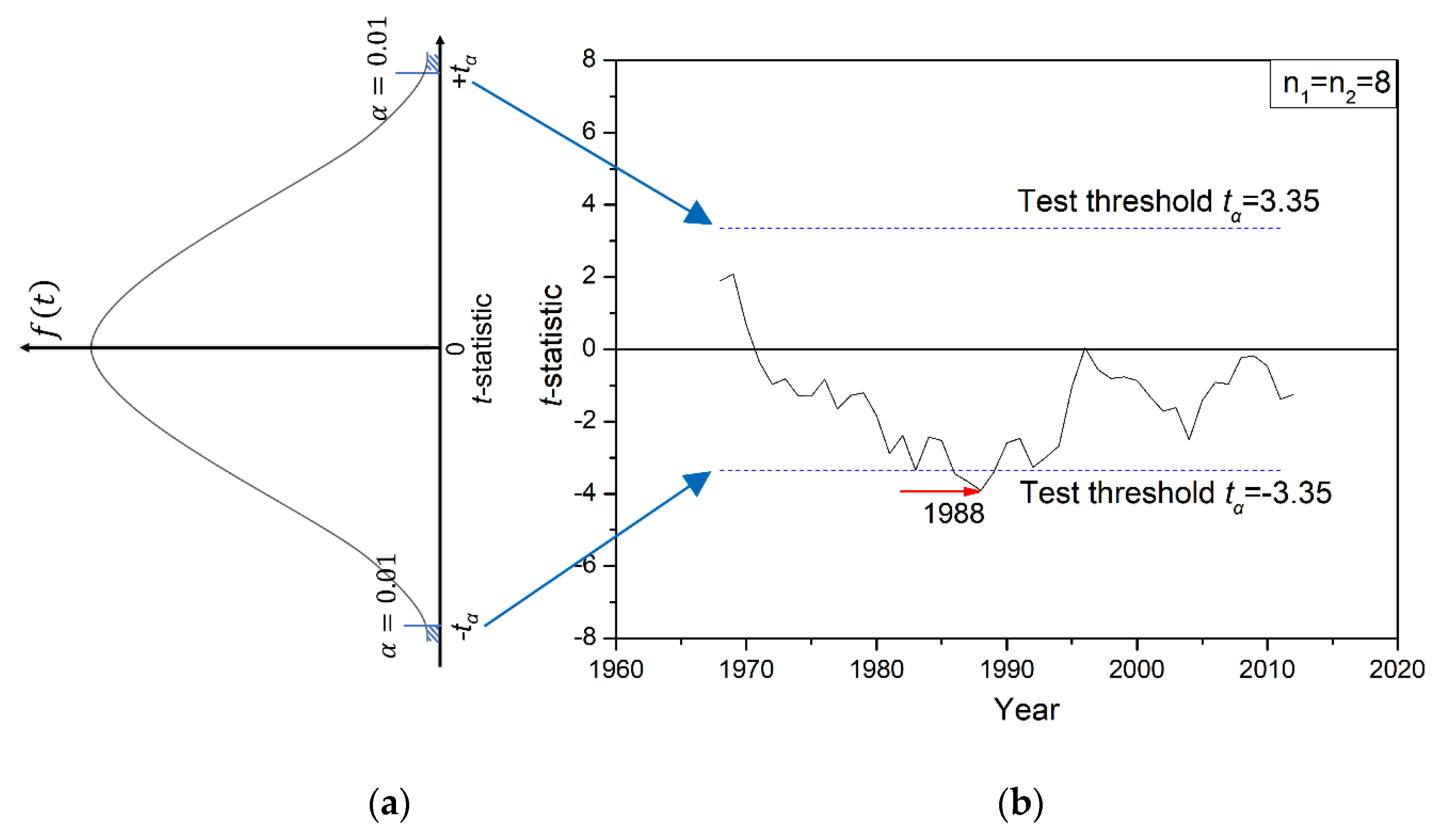
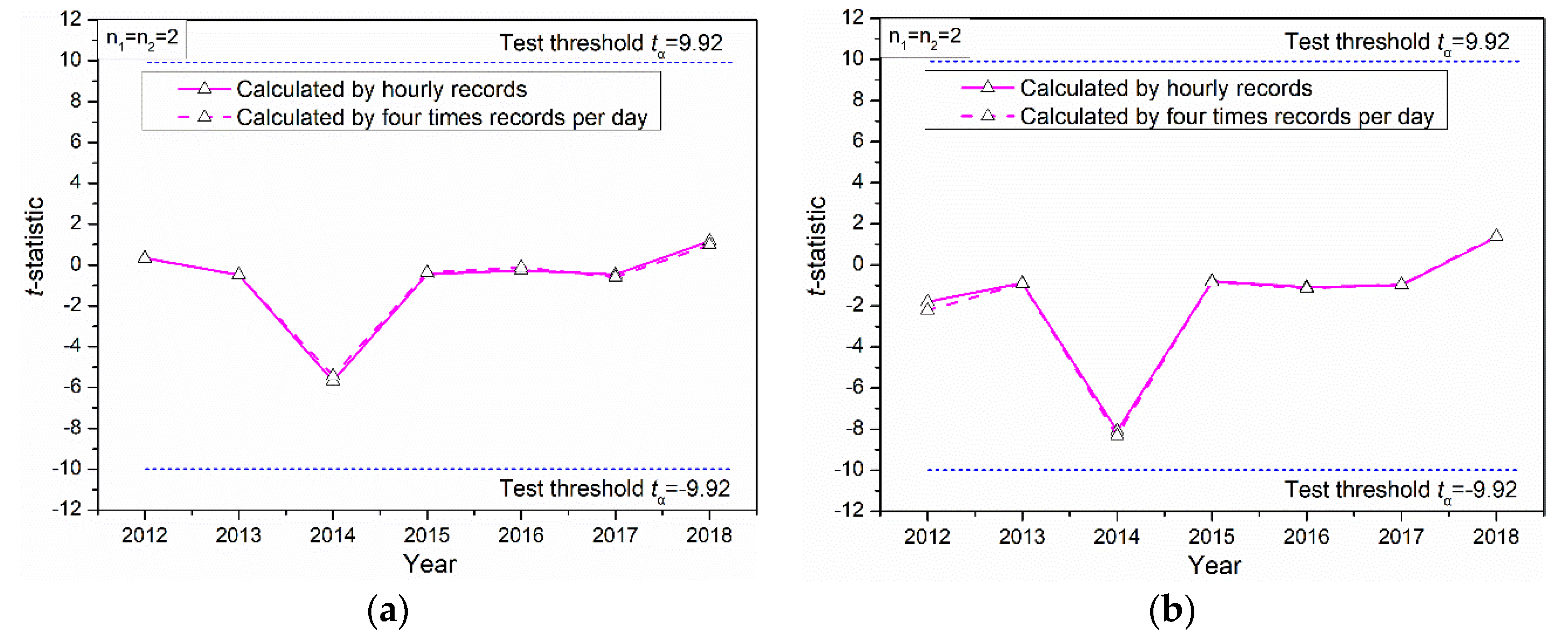
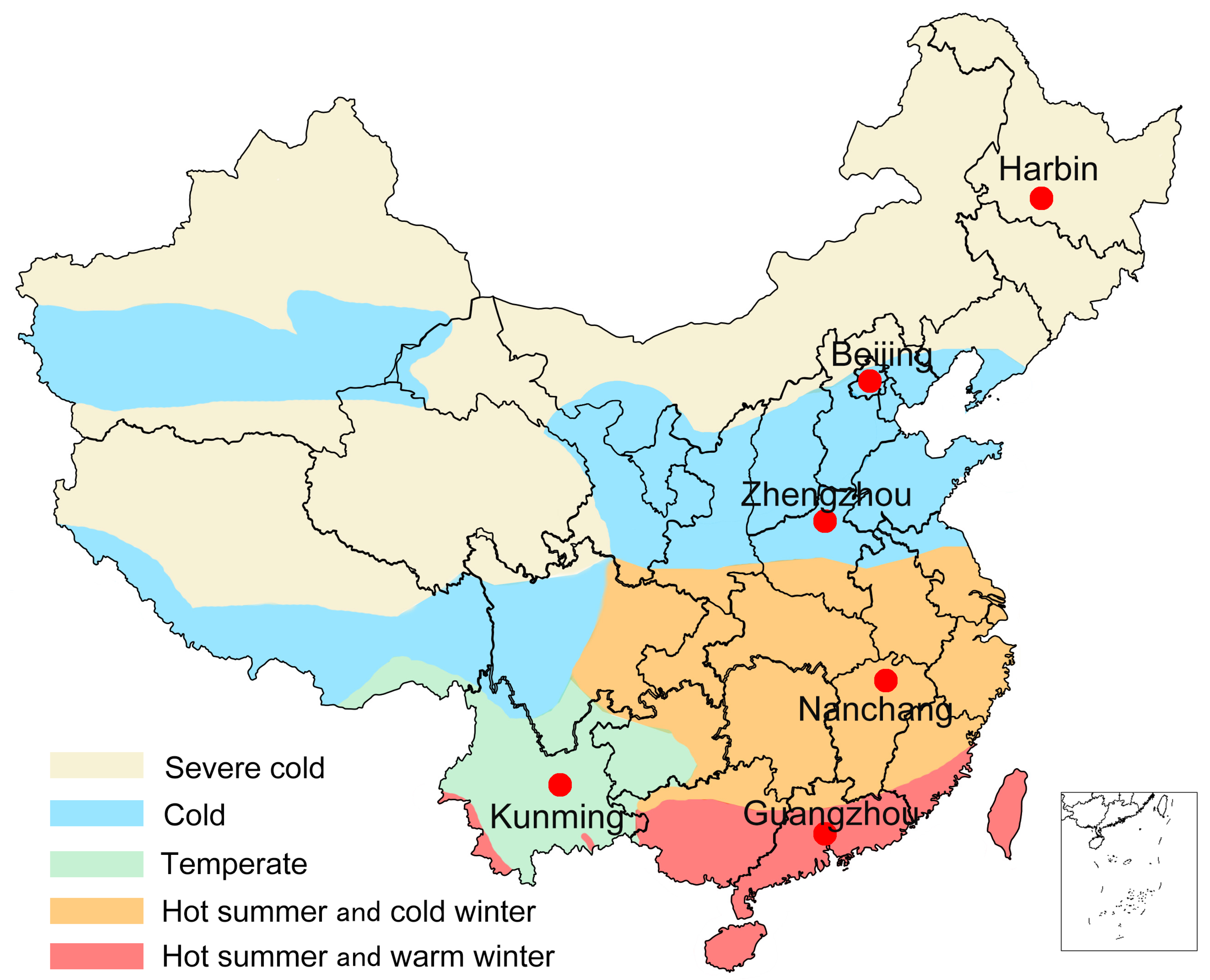
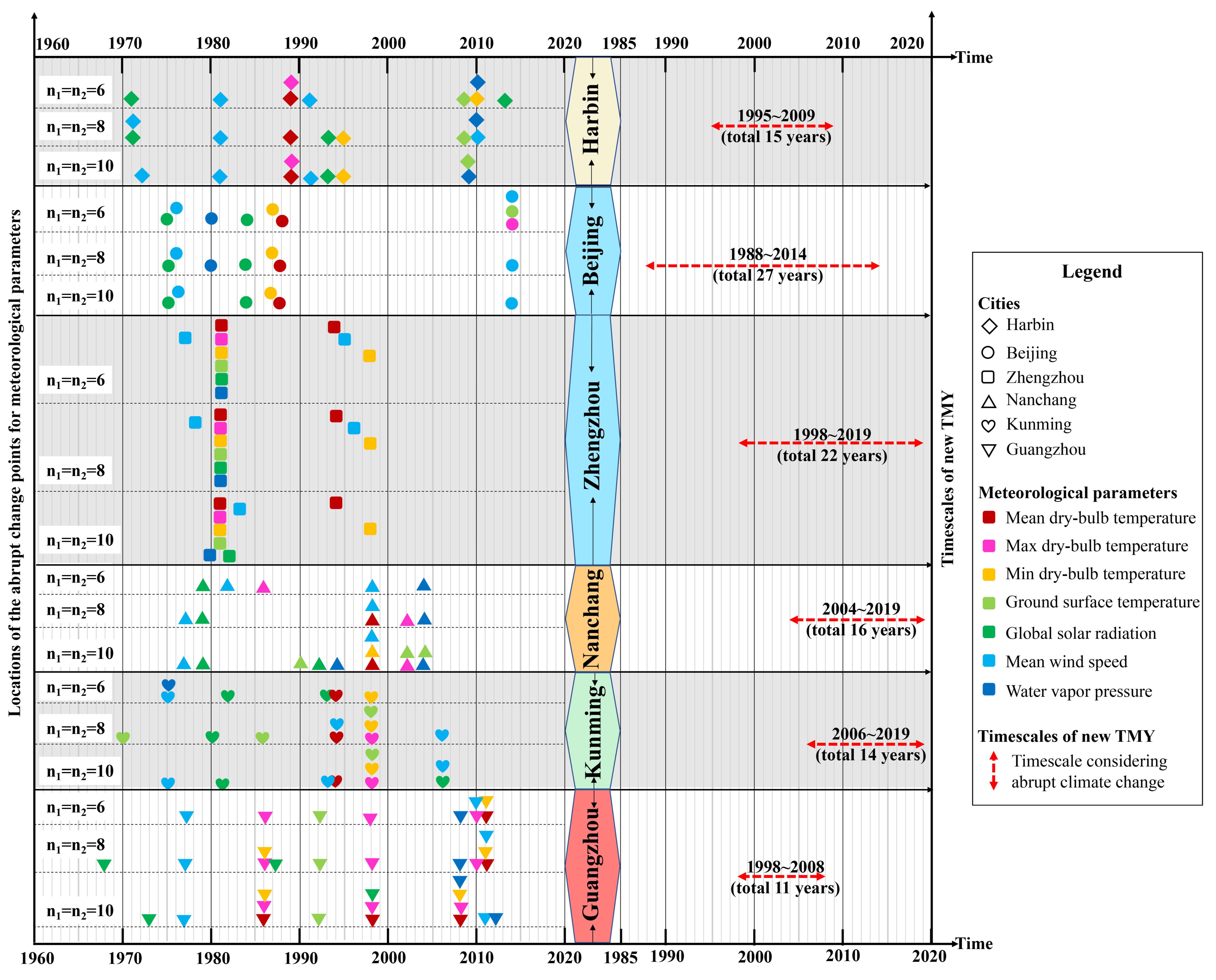
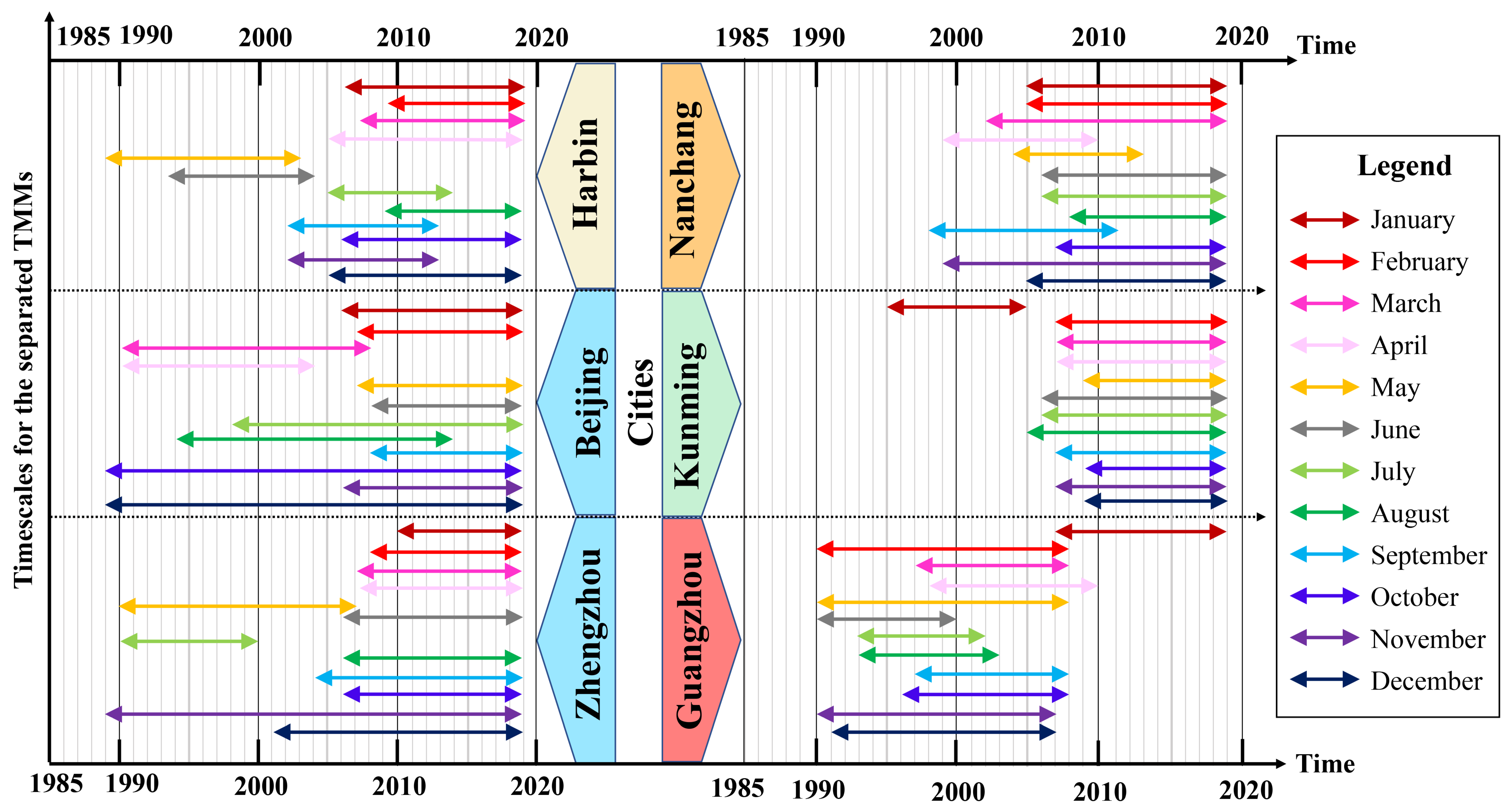


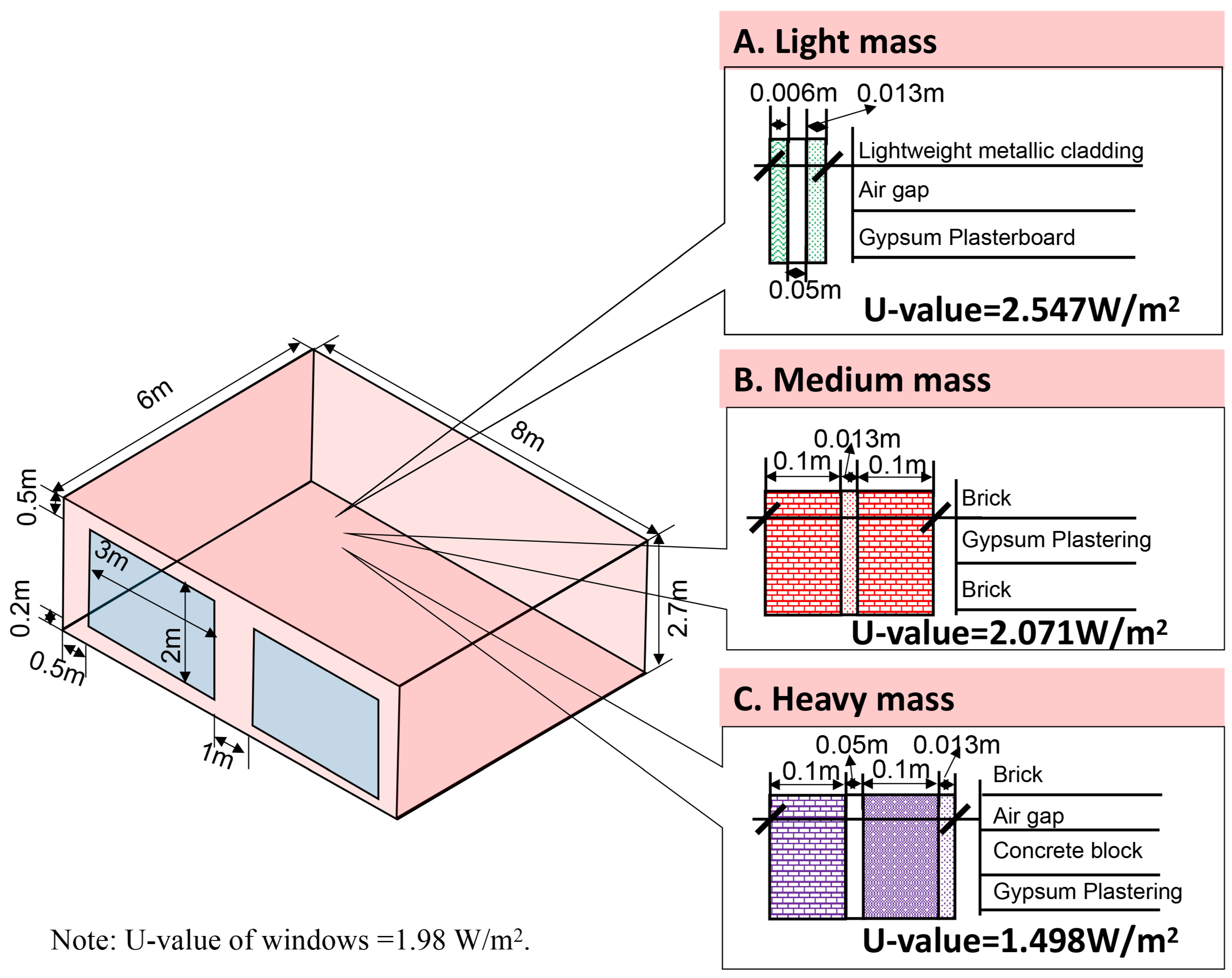
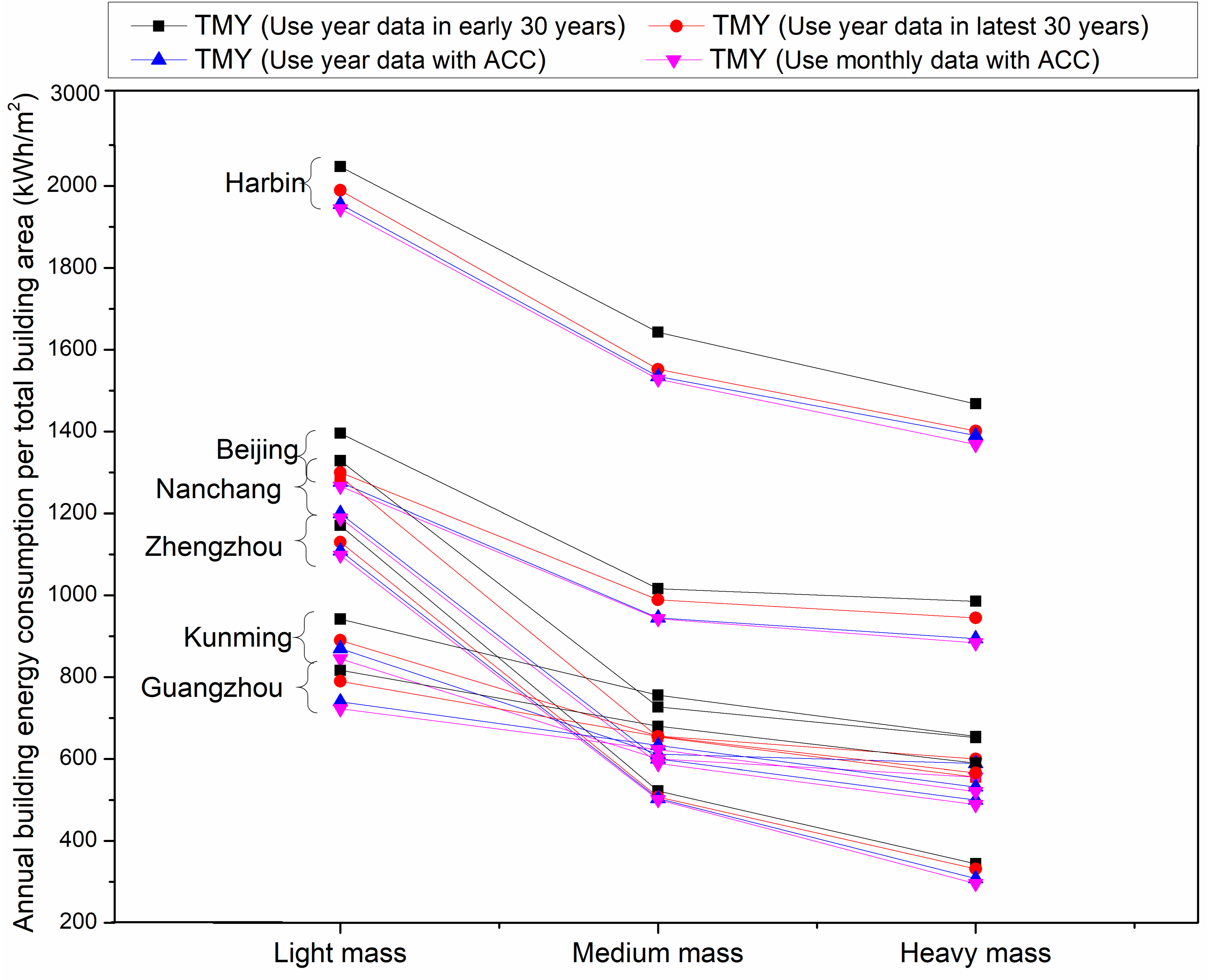
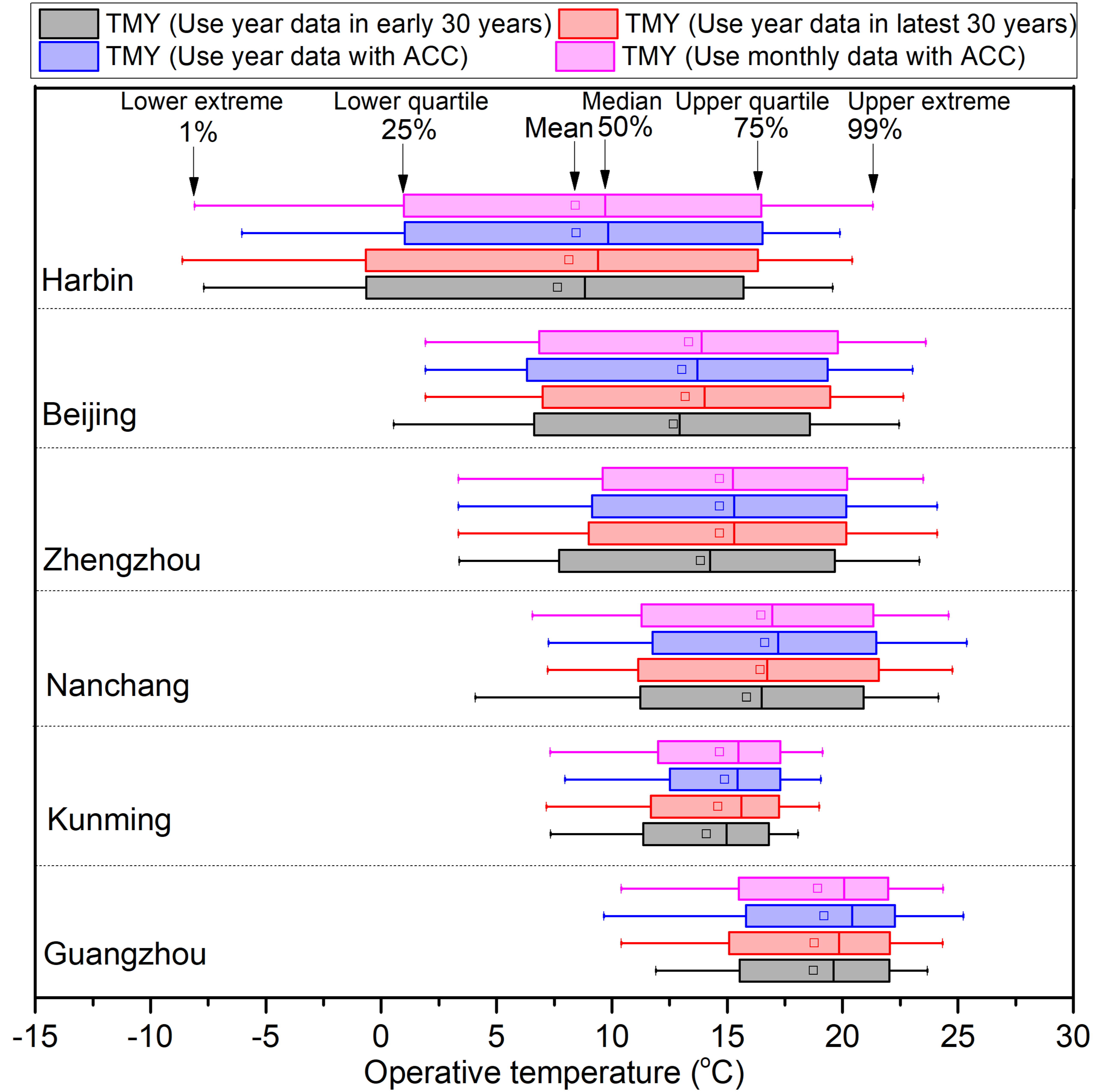

| Timescale | Jan. | Feb. | Mar. | Apr. | May | Jun. | Jul. | Aug. | Sep. | Oct. | Nov. | Dec. |
|---|---|---|---|---|---|---|---|---|---|---|---|---|
| (a) Harbin city | ||||||||||||
| ① | 2004 | 1997 | 2000 | 2001 | 2004 | 1996 | 2002 | 1997 | 2004 | 2006 | 2003 | 1999 |
| ② | 2008 | 2012 | 1995 | 2011 | 2004 | 2018 | 2013 | 2009 | 2009 | 2009 | 2015 | 2001 |
| ③ | 2008 | 2015 | 2011 | 2011 | 2001 | 1995 | 2012 | 2009 | 2009 | 2009 | 2008 | 2008 |
| ④ | 1982 | 1971 | 1982 | 1985 | 1986 | 1971 | 1996 | 1999 | 1995 | 1987 | 1986 | 1993 |
| (b) Beijing city | ||||||||||||
| ① | 2012 | 1991 | 2004 | 2000 | 1989 | 1988 | 2007 | 2008 | 2010 | 2013 | 1989 | 1990 |
| ② | 2012 | 1997 | 2004 | 1997 | 2010 | 2015 | 2011 | 2008 | 2015 | 2013 | 2007 | 1990 |
| ③ | 2007 | 2018 | 1993 | 1997 | 2016 | 2012 | 2000 | 2000 | 2015 | 2013 | 2013 | 1990 |
| ④ | 1998 | 1987 | 1996 | 1983 | 1980 | 1984 | 1991 | 1983 | 1981 | 1999 | 1977 | 1999 |
| (c) Zhengzhou city | ||||||||||||
| ① | 2018 | 2006 | 2009 | 2008 | 2016 | 2001 | 2002 | 2008 | 2001 | 2011 | 2014 | 2003 |
| ② | 2016 | 1997 | 2013 | 2008 | 2016 | 2008 | 2012 | 2008 | 2000 | 2008 | 2007 | 2013 |
| ③ | 2016 | 2015 | 2013 | 2008 | 1996 | 2013 | 1990 | 2008 | 2008 | 2008 | 2007 | 2003 |
| ④ | 1974 | 1994 | 1982 | 1986 | 1999 | 1995 | 1995 | 1979 | 1974 | 1984 | 2002 | 1990 |
| (d) Nanchang city | ||||||||||||
| ① | 2004 | 2016 | 2015 | 2015 | 2004 | 2007 | 2010 | 2007 | 2013 | 2012 | 2014 | 2006 |
| ② | 2004 | 2001 | 2006 | 2003 | 2004 | 1993 | 2006 | 2007 | 2013 | 2015 | 2003 | 2006 |
| ③ | 2018 | 2017 | 2006 | 2003 | 2004 | 2007 | 2006 | 2007 | 2016 | 2012 | 2008 | 2006 |
| ④ | 1983 | 1995 | 1979 | 2001 | 1978 | 1993 | 1986 | 1995 | 1991 | 2002 | 1985 | 1976 |
| (e) Kunming city | ||||||||||||
| ① | 2018 | 2009 | 2014 | 2006 | 2013 | 2009 | 2014 | 2012 | 2018 | 2014 | 2013 | 2006 |
| ② | 2003 | 2016 | 2012 | 2011 | 1993 | 2009 | 2000 | 2001 | 2004 | 2000 | 2005 | 1993 |
| ③ | 2003 | 2007 | 2014 | 2011 | 2016 | 2009 | 2014 | 2010 | 2018 | 2014 | 2014 | 2014 |
| ④ | 1990 | 1976 | 1988 | 1991 | 1972 | 1984 | 1981 | 1995 | 1990 | 1974 | 2001 | 1991 |
| (f) Guangzhou city | ||||||||||||
| ① | 2000 | 2002 | 2003 | 2006 | 2000 | 2007 | 2008 | 2002 | 2007 | 1998 | 2003 | 2004 |
| ② | 1996 | 2000 | 2009 | 1997 | 1993 | 2011 | 2000 | 2007 | 2003 | 1994 | 2003 | 2010 |
| ③ | 2008 | 2000 | 2003 | 2006 | 2000 | 1990 | 1998 | 2000 | 2003 | 1999 | 2003 | 1998 |
| ④ | 1978 | 1991 | 1982 | 1997 | 1983 | 1985 | 1986 | 1985 | 2002 | 1986 | 1999 | 1996 |
Publisher’s Note: MDPI stays neutral with regard to jurisdictional claims in published maps and institutional affiliations. |
© 2020 by the authors. Licensee MDPI, Basel, Switzerland. This article is an open access article distributed under the terms and conditions of the Creative Commons Attribution (CC BY) license (http://creativecommons.org/licenses/by/4.0/).
Share and Cite
Fan, X.; Chen, B.; Fu, C.; Li, L. Research on the Influence of Abrupt Climate Changes on the Analysis of Typical Meteorological Year in China. Energies 2020, 13, 6531. https://doi.org/10.3390/en13246531
Fan X, Chen B, Fu C, Li L. Research on the Influence of Abrupt Climate Changes on the Analysis of Typical Meteorological Year in China. Energies. 2020; 13(24):6531. https://doi.org/10.3390/en13246531
Chicago/Turabian StyleFan, Xinying, Bin Chen, Changfeng Fu, and Lingyun Li. 2020. "Research on the Influence of Abrupt Climate Changes on the Analysis of Typical Meteorological Year in China" Energies 13, no. 24: 6531. https://doi.org/10.3390/en13246531
APA StyleFan, X., Chen, B., Fu, C., & Li, L. (2020). Research on the Influence of Abrupt Climate Changes on the Analysis of Typical Meteorological Year in China. Energies, 13(24), 6531. https://doi.org/10.3390/en13246531







